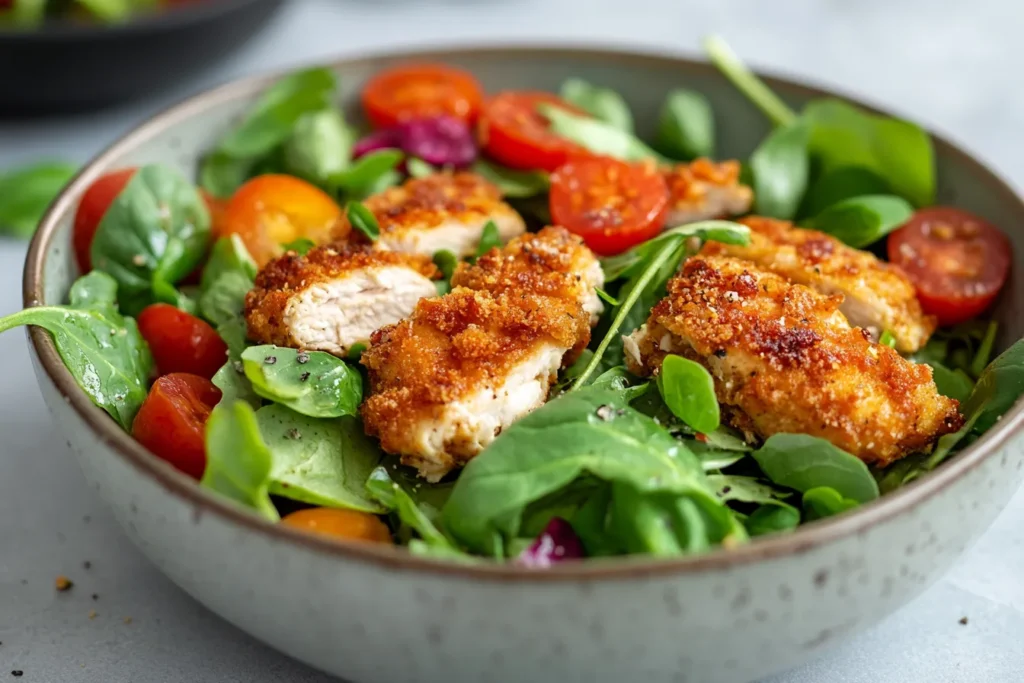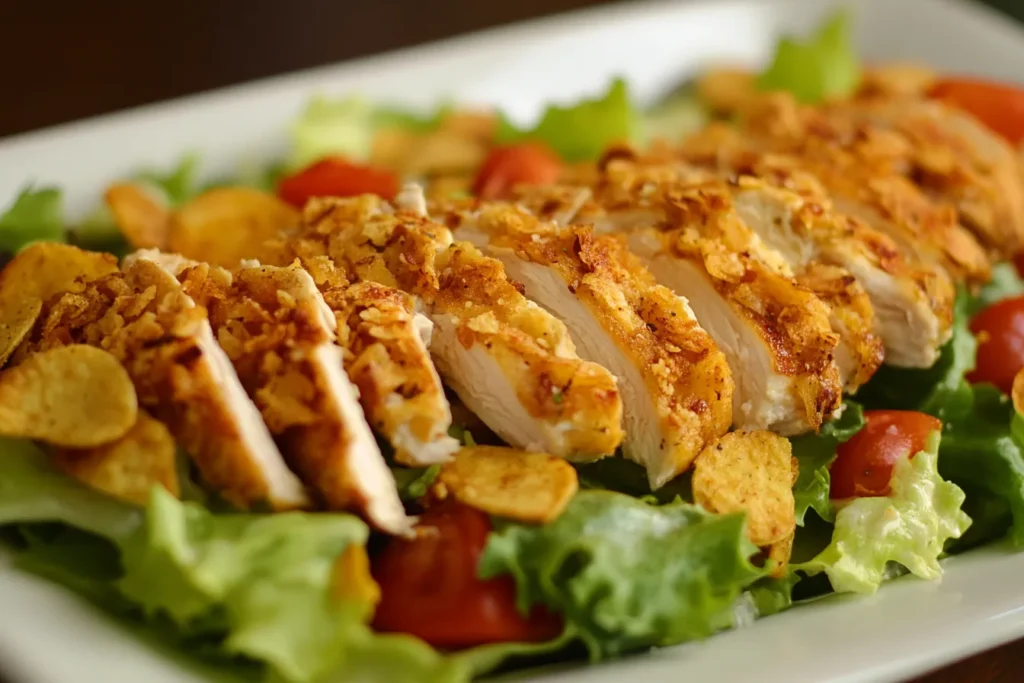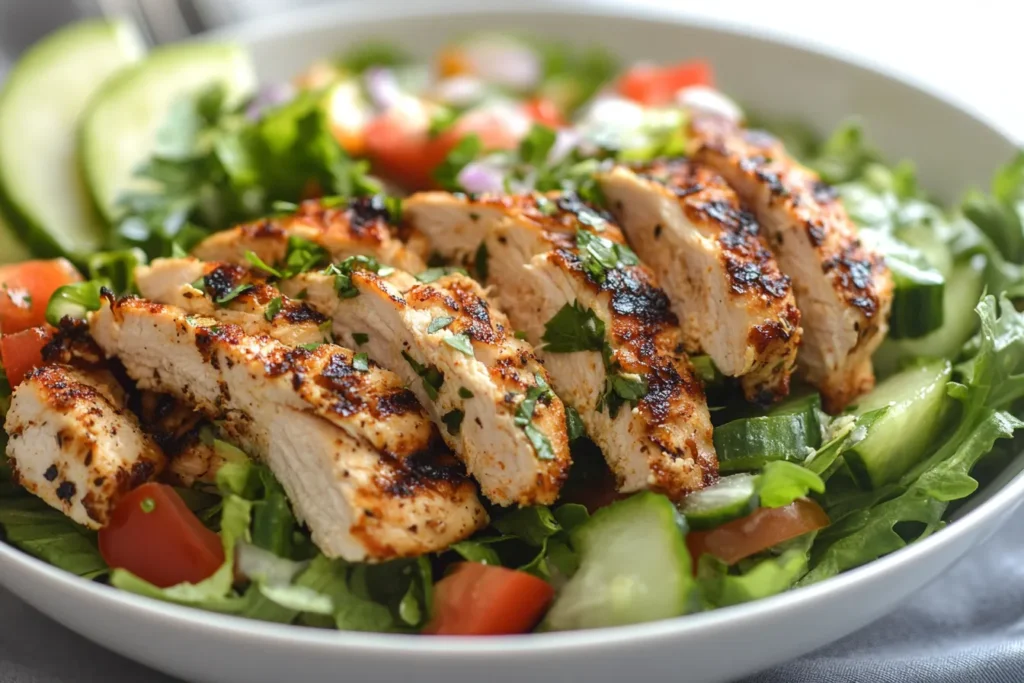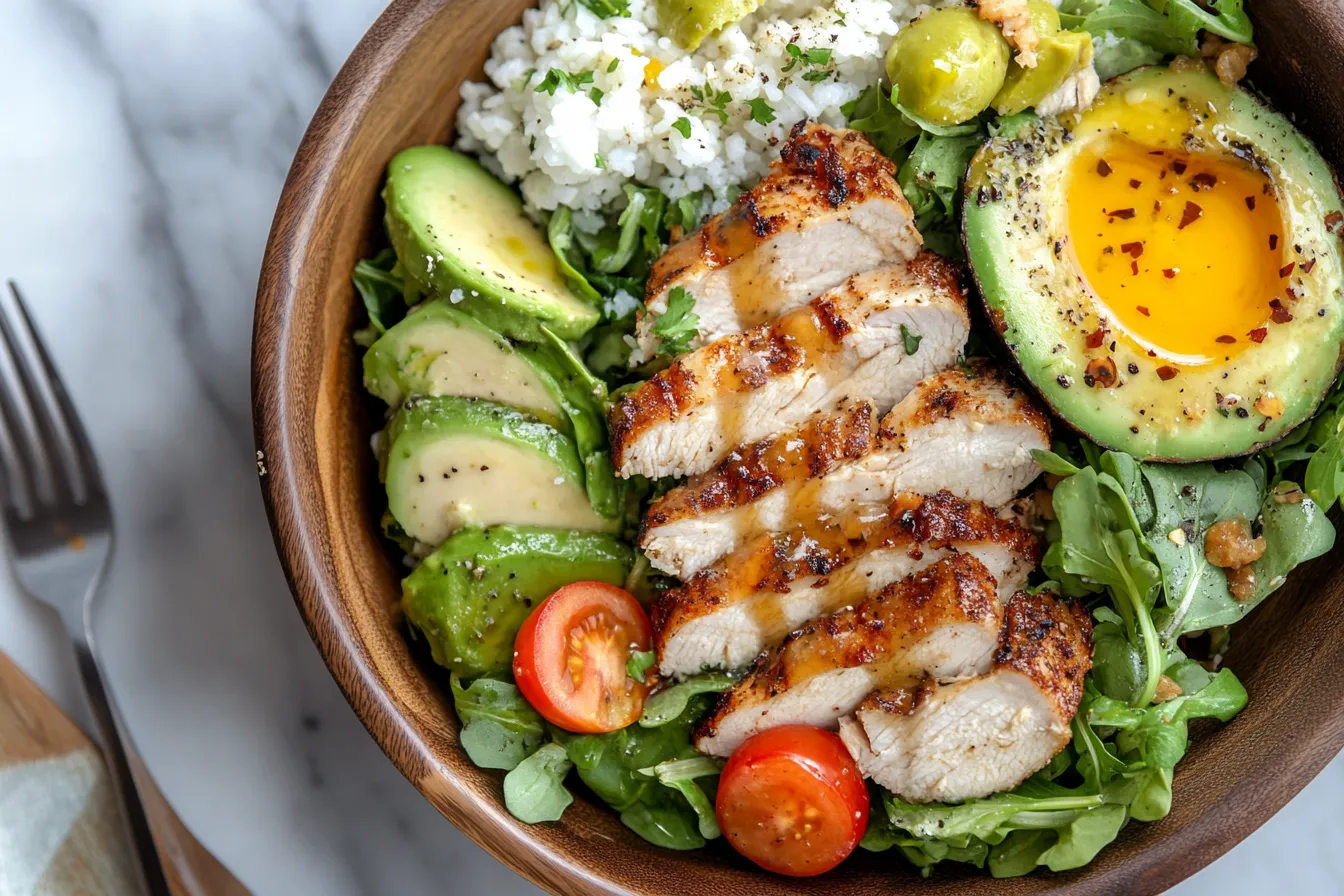Have you ever taken a bite of chicken, hoping for that irresistible crunch, only to end up with soggy skin instead? It’s so disappointing, but the good news is that perfectly crispy chicken skin is totally within reach. With just a few simple tips, you can get that golden, crunchy texture that makes every bite a delight. I’ve been there too—trying every trick in the book, from turning up the oven to crossing my fingers—but once I figured out the right techniques, there was no going back. Whether it’s roasted, pan-fried, or grilled, crispy chicken skin is a game-changer that elevates any dish. Ready to finally get it just right? Let’s dive in!
List of contents
1. Importance of Crispy Chicken Skin
Crispy chicken skin is a culinary delight, coveted for its crunchy texture and deep, savory flavor. It elevates dishes by creating a contrast between the crispy exterior and the juicy, tender meat underneath.
In the world of gastronomy, texture plays a crucial role. A dish’s mouthfeel can make or break the experience, and crispy skin adds that sought-after bite. Chefs across cuisines emphasize the importance of this layer as it complements various spices and seasonings, delivering an unforgettable flavor profile. Imagine biting into a well-cooked chicken thigh with a crackling sound that teases your senses—it’s the hallmark of perfectly crispy skin. Check out more recipes here.
2. Anatomy of Chicken Skin
To understand how to make chicken skin crispy, let’s dissect its composition. Chicken skin is primarily made up of:
- Fat: This provides moisture and flavor but can hinder crispiness if not rendered properly.
- Protein: Plays a critical role in achieving that golden-brown surface through the Maillard reaction.
- Moisture: The primary culprit that prevents crisping if not managed effectively.
Each of these components must be balanced during the cooking process to achieve the desired result. Proper rendering of fat ensures the skin isn’t greasy, while controlling moisture ensures it crisps up beautifully.
3. Science Behind Crisping
The magic of crispy skin lies in two scientific principles:
- Moisture evaporation: For skin to crisp, it must lose moisture. Excess water on the surface will steam rather than fry, leading to soggy results.
- Maillard reaction: This is the browning process where proteins and sugars react under heat, creating complex flavors and a golden, crispy surface.
Mastering these principles means controlling temperature and timing during cooking.
4. Choosing the Right Chicken

Not all chicken cuts are created equal when it comes to achieving crispy skin. Skin-on cuts with higher fat content, such as thighs and drumsticks, are ideal. These cuts allow for better rendering of fat, enhancing the texture and flavor of the skin.
On the other hand, chicken breasts, while leaner, require extra care to prevent the skin from drying out before crisping.
5. Prepping the Chicken
Preparation is everything when aiming for crispy skin. Start by thoroughly cleaning the chicken and, most importantly, drying the skin. Moisture is the enemy of crispness, so use paper towels to pat the skin dry.
For an extra edge, let the chicken air-dry in the refrigerator for a few hours. This step allows the skin to lose residual moisture, setting the stage for optimal crispiness.
6. Importance of Dry Brining
Dry brining involves rubbing salt onto the chicken and letting it rest. This technique:
- Draws out surface moisture.
- Seasons the chicken skin and meat evenly.
- Breaks down proteins for a tender yet crispy finish.
Let the chicken sit in the refrigerator uncovered during this process to maximize moisture removal.
7. Role of Fat in Crisping
The type of fat you use can make a difference. Options include:
- Butter: Adds richness but may burn at high heat.
- Ghee: Offers a higher smoke point while retaining buttery flavor.
- Neutral oils: Such
8. Seasoning for Crisp Skin
Seasoning chicken skin is an art. Too much seasoning can interfere with the texture, while too little compromises flavor. Salt is your best ally—it not only enhances flavor but also helps draw out moisture, a critical step in achieving crispness.
For an elevated flavor profile:
- Use a simple salt-and-pepper mix for a classic finish.
- Add dry spices like paprika, garlic powder, or cayenne for a kick.
- Avoid marinades at this stage, as they add moisture, which hinders crisping.
Apply your seasoning evenly to ensure every inch of the skin crisps perfectly.
9. Tools of the Trade
Achieving crispy skin requires more than just the right technique—it also demands the right tools. Here’s what you’ll need:
- Cast iron skillet: Retains and evenly distributes heat, ideal for pan-searing.
- Oven racks and baking trays: Allow hot air to circulate around the chicken, crisping all sides.
- Parchment paper: Prevents sticking while ensuring even heat distribution.
- Thermometer: Ensures the chicken reaches the perfect internal temperature without overcooking.
Having these tools on hand will simplify the process and guarantee consistent results.
10. Common Mistakes to Avoid
Even seasoned cooks make errors that can result in soggy skin. Avoid these pitfalls:
- Overcrowding the pan: Prevents proper airflow and traps steam.
- Using too much oil: Leads to greasy skin instead of a light, crispy texture.
- Skipping the drying step: Moisture is the number one enemy of crispy skin.
- Cooking at the wrong temperature: Low heat can render fat poorly, while excessively high heat may burn the skin.
With these basics mastered, you’re well on your way to achieving chicken skin perfection.
Methods and Techniques for Crispy Chicken Skin
1. Oven Roasting Method
Oven roasting is considered one of the most reliable methods for achieving perfectly crispy chicken skin. The even and controlled heat ensures consistent cooking throughout the process.
To get started, first preheat your oven to 425°F (220°C), as high heat is essential for rendering the fat and achieving a beautifully crisp texture. Next, prepare the chicken by thoroughly drying the skin to remove any excess moisture. Then, apply a light coat of oil or butter, which helps to enhance browning and crispiness.
After that, place the chicken on a wire rack set over a baking tray. This setup allows hot air to circulate evenly around the chicken and prevents sogginess by keeping it elevated from any rendered fat. Once everything is ready, roast the chicken with the skin-side up. Make sure to monitor the internal temperature, aiming for 165°F (74°C) for safe consumption. Generally, thighs will take about 25-30 minutes, while larger cuts, like a whole chicken, may require up to 45 minutes.
Additionally, halfway through cooking, baste the chicken with its rendered fat. This not only enhances the flavor but also contributes to an even, golden crispness on the skin. By following these steps, you can achieve consistently crispy and delicious chicken every time.th its rendered fat to enhance crispiness.
2. Pan-Seared Chicken
Pan-searing delivers a satisfying crunch and is ideal for smaller portions like chicken thighs.
Steps:
- Use a cast iron skillet for even heat distribution.
- Heat a small amount of neutral oil until shimmering, then place the chicken skin-side down.
- Apply gentle pressure to keep the skin in contact with the pan.
- Cook over medium heat until the skin is golden and crispy, about 7-10 minutes, then flip and cook the other side until done.
Avoid overcrowding the pan to maintain consistent heat.
3. Air-Fryer Techniques
Air fryers have revolutionized the quest for crispy chicken skin. Their convection technology circulates hot air, mimicking the effects of deep frying but with less oil.
Steps:
- Preheat the air fryer to 400°F (200°C).
- Pat the chicken dry and season generously.
- Arrange chicken pieces in a single layer to ensure even cooking.
- Cook for 20-25 minutes, flipping halfway through.
This method is perfect for those seeking a healthier, low-oil option without sacrificing crispiness.
4. Grilling for Crisp Skin

Grilling adds a smoky flavor while crisping the skin beautifully.
Steps:
- Preheat your grill, setting up two zones: direct and indirect heat.
- Start cooking the chicken over indirect heat to allow the fat to render without burning the skin.
- Move the chicken to direct heat for the final 5-7 minutes, crisping the skin to perfection.
Maintain a close watch, as the high heat can char the skin quickly.
5. Deep-Frying Chicken
Deep frying is the ultimate method for ultra-crispy chicken skin, often seen in fried chicken recipes.
Steps:
- Heat your oil (canola or peanut oil) to 350°F (175°C).
- Coat the chicken lightly in seasoned flour or batter for additional crispiness.
- Fry in small batches, ensuring the skin becomes golden and crispy, which typically takes 12-15 minutes depending on the cut.
This method requires precision but delivers unparalleled results.
6. Sous Vide and Finishing
For the perfectionist, sous vide ensures tender, evenly cooked chicken, and crisping the skin is the final step.
Steps:
- Cook the chicken sous vide at 150°F (65°C) for 1-2 hours.
- Dry the skin thoroughly after cooking.
- Finish in a hot skillet or under a broiler for that signature crispy texture.
Sous vide is excellent for achieving consistent results without overcooking.
7. Baking Powder Hack
Baking powder is a secret weapon for many home cooks seeking crispy skin. Its alkaline nature helps dehydrate the skin while enhancing browning.
Steps:
- Mix baking powder with salt and spices.
- Rub the mixture onto the chicken skin.
- Let the chicken rest uncovered in the refrigerator overnight before cooking.
The result? A crackling finish that’s hard to beat.
8. Broiler Tricks
The broiler is an excellent tool for achieving perfectly crispy chicken skin because it provides intense, concentrated heat.
First, preheat the broiler and position the chicken on the top rack, ensuring it is close enough to the heat for optimal results. Next, carefully monitor the chicken, as the skin can crisp up in as little as 3-5 minutes. Meanwhile, if you notice uneven browning, rotate the chicken to prevent burning and to ensure every part is evenly crisped. Finally, remove the chicken once the skin is golden and crunchy. Overall, this method is ideal for adding the final crispness to already-cooked chicken or finishing off your dish with a perfect, crackling texture.
9. Use of Marinades
Marinades can enhance the flavor of chicken, but they often hinder crisping due to added moisture. The key is to use marinades sparingly or opt for dry rubs.
For a balance of flavor and texture:
- Use acidic marinades (like yogurt or lemon juice) sparingly.
- Allow the chicken to dry out before cooking by patting it down thoroughly.
10. Resting After Cooking
Resting the chicken after cooking allows the juices to redistribute, preventing sogginess. Place the cooked chicken on a wire rack for 5-10 minutes before serving. This ensures the skin remains crisp while the meat stays juicy.
Enhancing the Experience of Crispy Chicken Skin
1. Pairing Crispy Chicken Skin with Dishes
CriCrispy chicken skin truly stands out when paired with carefully chosen sides and sauces that enhance its flavor and texture. Its savory crunch brings a unique dimension to any dish, while the right accompaniments take the experience to the next level.
Ideal pairings include:
- Mashed or roasted potatoes: Their creamy, smooth texture creates a delightful contrast to the crispiness of the skin.
- Coleslaw: With its refreshing crunch, it harmonizes beautifully with the crispy exterior of the chicken.
- Tangy sauces: Options like barbecue, honey mustard, or a zesty lemon aioli provide a flavorful counterpoint to the savory skin.
- Fresh salads: Light greens tossed in a tangy vinaigrette help offset the richness, creating a balanced bite.
Incorporating these elements not only enhances the overall meal but also ensures a memorable dining experience.
2. Storing Leftovers
To preserve crispy skin, proper storage and reheating are crucial.
Steps:
- Let the chicken cool completely before storing to avoid trapping steam.
- Store in an airtight container lined with paper towels to absorb moisture.
- When reheating, avoid the microwave. Instead:
- Use an oven at 375°F (190°C) for 10-12 minutes.
- Alternatively, reheat in a skillet over medium heat to restore crispiness.
These steps prevent soggy skin and maintain the original texture.
3. Exploring Global Techniques

Different cuisines around the world celebrate crispy chicken skin in unique ways:
- Peking Duck (China): Achieves paper-thin, crispy skin through air-drying and roasting.
- Karaage (Japan): Crispy fried chicken marinated in soy and ginger, then coated in potato starch.
- Pollo a la Brasa (Peru): Marinated in spices and roasted, delivering smoky, crispy skin.
- Southern Fried Chicken (USA): Deep-fried with a seasoned batter for an ultra-crispy finish.
Incorporating these global techniques adds cultural depth to your crispy chicken repertoire.
4. Healthy Alternatives
For those seeking a healthier approach, you can still achieve crispy skin without excessive oil:
- Air frying: Requires minimal oil while delivering a crisp finish.
- Baking powder rubs: Enhance crispiness without added fat.
- Grilling: Uses rendered fat and high heat for a healthier, smoky crisp.
These methods balance health-conscious choices with culinary satisfaction.
5. Flavor Infusions
Enhance the flavor of crispy chicken skin by incorporating herbs, aromatics, and spices:
- Under-skin marinades: Slide butter mixed with garlic, rosemary, or thyme under the skin before cooking.
- Citrus zest: Adds brightness to the crispy exterior.
- Spice blends: Paprika, cumin, or chili powder add depth and heat to the flavor profile.
Infusing the skin with these ingredients ensures each bite is as flavorful as it is crispy.
6. Specialty Ingredients
Uncommon ingredients can elevate your crispy chicken game:
- Duck fat: Adds a luxurious, rich flavor to the skin.
- Truffle oil: For a gourmet twist.
- Smoked paprika or sumac: Deliver unique, smoky, and tangy notes.
Experimenting with these ingredients can transform a simple dish into a culinary masterpiece.
7. Catering for Dietary Needs
Meeting dietary restrictions doesn’t mean giving up on crispy chicken skin.
To make it gluten-free, almond flour or cornmeal works wonderfully as a substitute, providing a satisfying crunch.
For a low-sodium alternative, minimize salt and instead highlight the flavors of aromatic spice blends.
In keto-friendly versions, skipping the batter and concentrating on rendering the natural fat from the skin ensures both crispiness and flavor.
With a few adjustments, crispy chicken skin can easily fit into diverse dietary preferences.
8. Presentation Tips
Serving crispy chicken is as much about aesthetics as it is about flavor.
- Plating: Serve chicken pieces atop colorful sides to make the golden skin pop.
- Garnishing: Add fresh herbs like parsley or cilantro for a vibrant touch.
- Stacking: Layer chicken pieces for an appetizing display of texture.
A well-presented dish enhances the overall dining experience.
9. Troubleshooting Issues
Even with the best techniques, issues may arise. Here’s how to fix common problems:
- Soggy skin: Ensure thorough drying before cooking and avoid overcrowding.
- Uneven browning: Rotate the chicken or adjust cooking methods for consistent heat.
- Over-browning: Lower the cooking temperature and monitor closely.
Knowing how to troubleshoot ensures a consistently excellent outcome.
10. Recipes to Try
Here are five must-try recipes for crispy chicken skin:
- Classic Oven-Roasted Chicken Thighs: Seasoned simply with salt and pepper for a pure crispy experience.
- Garlic Herb Pan-Seared Chicken: Infused with rosemary and garlic for added depth.
- Air-Fried Buffalo Chicken Wings: Tossed in buffalo sauce after crisping for a spicy kick.
- Crispy Buttermilk Fried Chicken: A Southern classic with a rich, crunchy coating.
- Peking-Style Chicken: Air-dried and roasted with a glaze for a Chinese-inspired twist.
FAQs
1. Why is my chicken skin not crispy?
Moisture is likely the issue. Pat the skin dry and avoid overcrowding during cooking.
2. Can you get crispy skin without oil?
Yes, baking powder or dry-brining can help achieve crispiness with minimal or no oil.
3. What’s the best chicken cut for crispy skin?
Thighs and drumsticks, as their higher fat content renders beautifully during cooking.
4. Does baking powder make chicken skin crispy?
Yes, its alkaline nature helps dehydrate the skin and enhance crispiness.
5. How do I prevent chicken skin from burning?
Cook at medium to high heat and monitor closely, especially with direct heat methods like grilling.
6. Can I make crispy skin on boneless chicken?
Yes, but bone-in cuts tend to render fat more effectively, resulting in better texture.
7. What’s the best oil for crispy chicken skin?
Neutral oils like canola or high-smoke-point fats like ghee are ideal.
8. Can I reheat crispy chicken and keep it crispy?
Yes, reheating in the oven or skillet maintains crispiness better than the microwave.
9. Why does my chicken skin stick to the pan?
Ensure the pan is preheated and use a small amount of oil or fat to prevent sticking.
10. Is crispy chicken skin healthy?
While it’s higher in fat, opting for methods like air frying can reduce the oil content while retaining crispiness.
